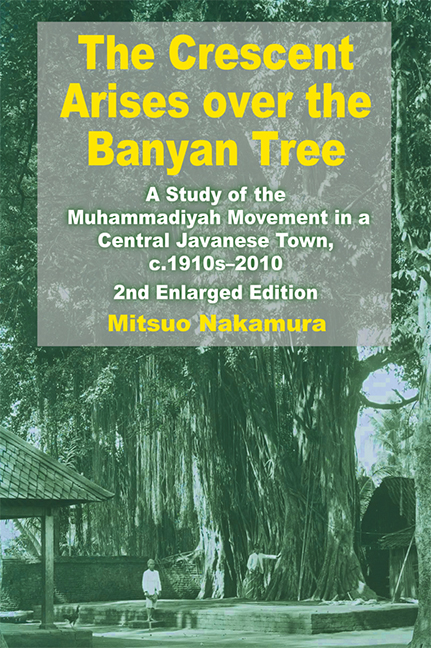 The Crescent Arises over the Banyan Tree
The Crescent Arises over the Banyan Tree Book contents
- Frontmatter
- Dedication
- Epigraph
- Contents
- List of Figures and Maps
- List of Tables
- List of Boxes
- Foreword to the Second Edition
- Preface to the Second Edition
- Foreword to the First Edition
- Preface to the First Edition
- Notes
- Map
- PART I DEVELOPMENT OF THE MUHAMMADIYAH IN KOTAGEDE, c.1910s–1972
- 1 Introduction: The Islamization of Java
- 2 Kotagede under the Banyan Tree: Traditional Society and Religion
- 3 The Beginning of the Muhammadiyah: Court Religious Officials and the Urban Middle Class
- 4 The Development of the Muhammadiyah: Religion and Social Action
- 5 The Sociology of Ummat Islam: Structure and Anti-Structure
- 6 The Ideology of the Muhammadiyah: Tradition and Transformation
- 7 Conclusion: Re-Islamization of Java
- Postscript to Part I
- PART II KOTAGEDE REVISITED, 1972–2010
- Bibliography
- Glossary
- Appendices
- Index
- About the Author
6 - The Ideology of the Muhammadiyah: Tradition and Transformation
from PART I - DEVELOPMENT OF THE MUHAMMADIYAH IN KOTAGEDE, c.1910s–1972
Published online by Cambridge University Press: 21 October 2015
- Frontmatter
- Dedication
- Epigraph
- Contents
- List of Figures and Maps
- List of Tables
- List of Boxes
- Foreword to the Second Edition
- Preface to the Second Edition
- Foreword to the First Edition
- Preface to the First Edition
- Notes
- Map
- PART I DEVELOPMENT OF THE MUHAMMADIYAH IN KOTAGEDE, c.1910s–1972
- 1 Introduction: The Islamization of Java
- 2 Kotagede under the Banyan Tree: Traditional Society and Religion
- 3 The Beginning of the Muhammadiyah: Court Religious Officials and the Urban Middle Class
- 4 The Development of the Muhammadiyah: Religion and Social Action
- 5 The Sociology of Ummat Islam: Structure and Anti-Structure
- 6 The Ideology of the Muhammadiyah: Tradition and Transformation
- 7 Conclusion: Re-Islamization of Java
- Postscript to Part I
- PART II KOTAGEDE REVISITED, 1972–2010
- Bibliography
- Glossary
- Appendices
- Index
- About the Author
Summary
So, to get along well with your neighbour, the way must be proper. When the neighbour just drops in to chat with you (omong-omongan), just welcome him and chat. If he doesn't pray yet, that's all right. You should not make a fool of him (aja ngolok-olok). You should not tease him irritatingly (aja ngece-ece). If he falls sick, then just go and see (tuwéni); if in need, go and help; if down with a cold, go and give a coin-massage (keroki). Well, it is up to you how you actually do your help. But that is what is called sasrawungan ingkang saé (harmonious way of social intercourse). ‘Aisyiyah people, Muhammadiyah people, must be able to do this. (Speech by Bapak A.R. Fakhruddin, President of Muhammadiyah, 28 November 1971, Kotagede).
RELIGIOUS COMMUNICATIONS AMONG JAVANESE MUSLIMS
In the preceding chapters I have attempted to make two major points. The first, a historical point, has been that the Muhammadiyah movement must be regarded as a development from within Javanese society rather than as a ready-made import from without. The second, a more contemporary and sociological point, has been that the social basis of the Muhammadiyah movement has become greatly widened and it is no longer confined to a small segment of society like the urban bourgeoisie. In this chapter I shall examine critically another aspect of the conventional view that reformist Islam, including the Muhammadiyah, is fundamentally alien to Javanese or non-Javanese, in cultural terms (e.g., Benda 1965, p. 133; Geertz 1968, p. 16). I shall argue that reformist Islam is not antithetical to Javanese culture but an integral part of it, and what reformists have been endeavouring is, so to speak, to distil a pure essence of Islam from Javanese cultural traditions. The final product of distillation does retain a Javanese flavour, just as any highly pure liquors cannot lose their local flavours. But the universalistic essence of Islam is more fundamental, and it should be appreciated as it is first and foremost.
- Type
- Chapter
- Information
- The Crescent Arises over the Banyan TreeA Study of the Muhammadiyah Movement in a Central Javanese Town, c.1910s-2010 (Second Enlarged Edition), pp. 165 - 207Publisher: ISEAS–Yusof Ishak InstitutePrint publication year: 2012
